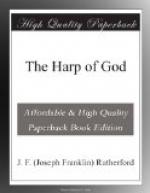[258]Lucifer, who became Satan, who had once been associated with the holy angels and who had seduced some of their fellow angels, had for centuries opposed Jehovah and specially tried to destroy Jesus. Jesus had been sent into the world that he might destroy the works of Satan; and now, having been raised from the dead, he would ultimately “destroy him that had the power of death, that is, the devil,” which destruction would guarantee the deliverance of the human race. (Hebrews 2:14) Now Jesus had broken the bonds of death, being raised by Jehovah to power and glory, demonstrating the fact that he was fully approved by Jehovah. He now proved that he was worthy to be praised; and without question he received the unlimited praise of all the heavenly host. The Revelator says: “And I beheld, and I heard the voice of many angels round about the throne and the beasts and the elders: and the number of them was ten thousand times ten thousand, and thousands of thousands; saying with a loud voice, Worthy is the Lamb that was slain to receive power, and riches, and wisdom, and strength, and honor and glory, and blessing.” —Revelation 5:11,12.
SCRIPTURAL PROOF
[259]It was not their previous knowledge of the Scriptures and their faith in them that Christ Jesus would arise from the dead which induced the disciples to believe that he was risen, but it was what they actually saw and experienced that led them to this conclusion. The knowledge gained by experience, coupled with the knowledge of the Scriptures subsequently acquired by them, not only established beyond a doubt in their own minds the resurrection of the Lord Jesus, but it emboldened them to declare the message on every opportune occasion to others and to emphasize this great doctrine of truth in their epistles to the church.
[260]It will profit us here to consider the Scriptural testimony given by the Evangelist in proof that Jesus did arise from the dead three days after his crucifixion. There have always been some that denied the resurrection and hence it is always well to fortify ourselves against such denial, as well as to strengthen our own faith. It must be remembered that the writers of these gospels were not learned men; they were not such men as would arrange a fraudulent scheme to deceive anybody. There would be no occasion for them to do this. The fact that they did not expect a resurrection and gave evidence of that by their conduct and their speech at and just after the Lord’s death is strong circumstantial evidence that their testimony subsequently given is true. Besides this, the testimony itself bears all the earmarks of truth.
[261]At the time Jesus died there was an earthquake. The Roman centurion who stood by exclaimed “Truly this was the son of God!” “When the even was come, there came a rich man of Arimathea, named Joseph, who also himself was Jesus’ disciple: he went to Pilate, and begged the body of Jesus. Then Pilate commanded the body to be delivered. And when Joseph had taken the body, he wrapped it in a clean linen cloth, and laid it in his own new tomb, which he had hewn out in the rock: and he rolled a great stone to the door of the sepulchre, and departed and there was Mary Magdalene, and the other Mary, sitting over against the sepulchre.”—Matthew 27:57-61.




